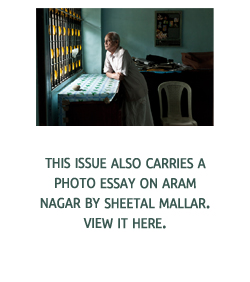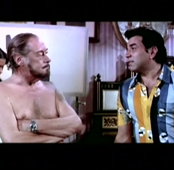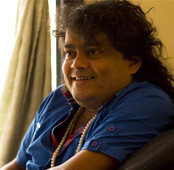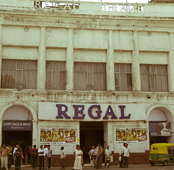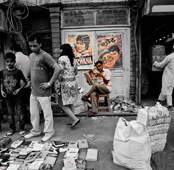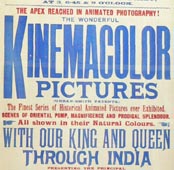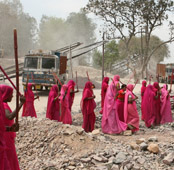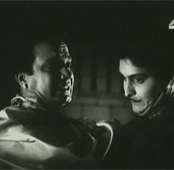-
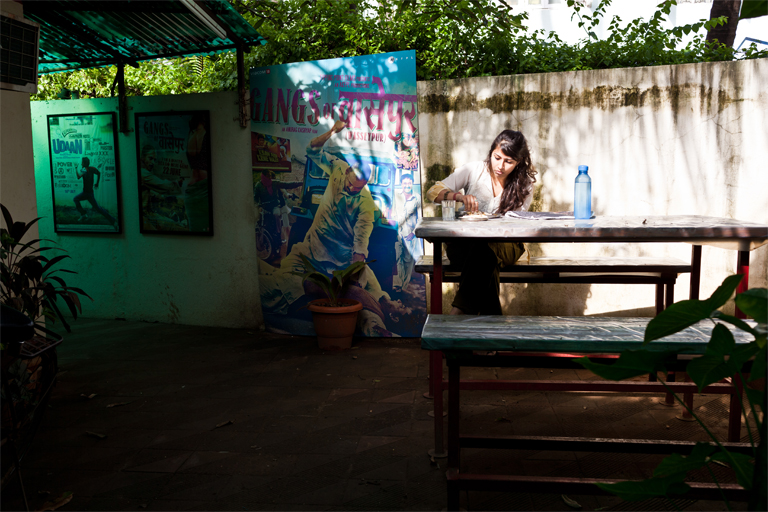 The AKFPL (Anurag Kashyap Films Pvt. Ltd.) office at lunch time | Sheetal Mallar for The Big Indian Picture
The AKFPL (Anurag Kashyap Films Pvt. Ltd.) office at lunch time | Sheetal Mallar for The Big Indian Picture
Here is the story of Aram Nagar, whose houses went from being British barracks to bungalows of leisure. The story of how it became a hub for those wanting to make it in the movies and those at the helm of a new kind of Hindi cinema. And the story of how it may all disappear
73 year old Balbir Singh Sandhu is in the middle of making his first film. He is stocky and has a flowing white beard. He wears a turban that is so faded that it is difficult to make out what its original color was. Today he is dressed in a loose collar t-shirt and baggy trousers which give him the appearance of a disheveled Santa Claus on a sabbatical. We are at his office in Aram Nagar 2, in Versova, Mumbai. Glossy posters of his unfinished film take up most of a large softboard. Unknown bikini clad models in and around a swimming pool. Men in suits and ties, and women with plunging necklines, who look into the camera in a medley of expressions that signify lust, suspicion, envy, rage— separately and all at once. A couple, presumably the leading pair, gaze at each other coyly in the middle of an embrace. A man reaches out towards you with a murderous glint in his eye. Just below him is the film’s title: I Will Find My Murderer. The ‘I’ is in the shape of a Christian cross, bleeding at the top.
Sandhu is producing the thriller under his own banner, Prabhjot Films, named after his son, who passed away in the 1970s, at a very young age. He finished writing it two years ago and began shooting it last year. But he has finished only half of it because, as he puts it: “I’m working with new actors and this always takes more time”. Accompanying the posters, on the softboard, are two photographs of Sandhu with yesteryear superstar Rajesh Khanna.
On another wall, behind his desk, are worn out laminated certificates of recognition for social activism. They explain a second signboard—one larger than the plate that says Prabhjot Films—both propped up on stands just outside his office. A signboard claiming that this is also the Andheri West office for the All India Human Rights Association (AIHRA), Maharashtra.
Sandhu tells us that he heads the district committee for the association. He insists that we refer to him as Balbir Badshah (‘Badshah’ meaning ‘king’), instead of using his actual name. He says that’s what everyone in the vicinity calls him. But he doesn’t have a specific answer for what exactly his social work involves. “I’ve been a social worker since 1954,” he says cryptically. “Even when I was young, in my hometown, I would help marry young couples and organize events for festivals.” Nowadays, he says, he helps resolve “domestic disputes”. He is also a part of protests in the area against a builder who wants to redevelop Aram Nagar by demolishing existing bungalows and cottages.
Cottages like the one that Sandhu lives and works out of. This is one of two spaces that he uses as offices. Despite the garish film posters, there is an air of tranquility. It is furnished simply with two small wooden tables, a desk, basic plastic and foam swivel chairs and a cramped computer workstation. Sandhu says he uses this office for his AIHRA meetings. At the other end of the house is another, more done-up room that Sandhu uses to meet people for his film. It is lit brightly. There are stained glass panels on the walls and a smooth table topped with black granite.
Sandhu moved to this house, from Karnal, in Punjab, 42 years ago. “I was a business man,” he says. “I was involved in many businesses, especially the business of chemicals.” He came to Bombay to become a hotelier but didn’t succeed. “Then I was also writing in the newspapers before that,” he goes on. “So, after that, as a writer, I entered films.” He wrote a film called Vaishya (Prostitute), which was directed by Syed Hussain, whom he calls his guru. But the film did not see a release. Then Sandhu wrote Aashiana (Home), a 1974 film, also directed by Hussain, which had a very young Neetu Singh, who would go on to become one of the biggest stars of the decade. Sandhu says he did some more “uncredited writing” in the 1970s, and then stopped. His “many businesses” kept him going. His daughter got married and settled in the UK. His wife passed away.
Outside Sandhu’s house a tin roof, held up by iron poles, forms a makeshift garage for his silver colored car— a Hyundai Accent. The house itself seems to be a squat, smallish structure. But it has been improvised. A section of the porch has been covered by thick tarpaulin, straw mats, and the kind of cloth used in shamianas (tent shelters used for outdoor parties and feasts) to fashion a room out of it. It is hard to imagine that this house was once one of many structures used to house British soldiers during the Second World War.
***
Sandhu’s house is one of 367 in Aram Nagar, an area divided into Parts 1 and 2 and spread out over 40 acres of land in Versova, a locality in the suburb of Andheri, in North-West Mumbai. In the 1930s, when the country was under British rule, these buildings were British Army barracks. Today they contain, among other occupants, many photography and casting studios and the offices of some of the leading lights of the Hindi film industry. In fact, the area has become a hub for what is loosely called ‘new Bollywood’. A Bollywood that makes saleable films which steer away from its more formulaic and starry big-budget productions, and has a greater consideration for meaningful cinema. The advent of filmwallahs in the area initially met with resistance from the older residents but they eventually reconciled. Today Aram Nagar faces a new threat. A state authority called the Maharashtra Housing And Development Association (MHADA) wants to demolish most of the houses and build apartment blocks in their place. They have appointed a private construction company to do so.
***
“They were single storied brick buildings, with asbestos roofs,” says 78 year old Hynginus D’Lima about the barracks that have become Aram Nagar. “The area where the Bhavan’s college complex stands today also had British barracks,” he adds. He has been born and brought up in Andheri and as such is the one of the oldest and most authoritative voices on the history of the suburb. He draws up a rough map to explain the topography of the land in the 1930s. “Versova was not thought to be a part of Andheri then,” he explains. “And neither Versova, nor Andheri, were a part of Bombay.” Before the barracks came, in the area where Bhavan’s College is now, there was a Japanese golf course and club. “They had to leave during the war, because Japan allied with Germany— the enemy,” D’Lima says. We are at his house, a single storied building called ‘Herwish’, in Andheri Gaonthan, Lane 1, where D’Lima has lived all his life. Her-wish, because this was a house his mother really wanted. “There was a narrow strip of road through marshy land which connected Andheri to Versova,” D’Lima continues. This marshy land is what is now known as Four Bungalows and Seven Bungalows. “A bus service was begun on this road,” says D’Lima. “Connecting the two areas.” But because the buses were double deckers, and the road too narrow, they would often keel over. The only other means of transport was a kind of bullock cart that had rubber tyres.
After Independence, in 1947, the barracks were used to house Sindhi refugees who came in from Pakistan after the Partition, many of whom extended the basic brick structures into more comfortable housing. By the 1960s many of the refugees had moved out from here to more central locales in the city of Bombay, and the state government took over the land and allotted these homes as permanent housing to Class 4 employees (the junior-most grade in government service). Eventually, a lot of them moved out too. Many of the current residents have had the leases of the previous occupants transferred to their names, and have stayed on as tenants of the state. “They beatified the houses,” says D’Lima referring perhaps to the tacky embellishments to be found on most houses in the area. Some tenants believe that their long stay here has given them rights of ownership. The State believes otherwise.
As roads in the area got better, and Versova was absorbed into Andheri, and Andheri into Bombay, which became Mumbai, the builders came. Robust skyscrapers now loom threateningly over the midget bungalows of Aram Nagar. The bungalows and cottages themselves, however, are still connected to one another by a maze of dirt tracks, which can be a nightmare to navigate. The tracks get flooded during the monsoons and sprout greenery immediately after, giving the locality the eerie feel of a hamlet in the middle of Mumbai, that does not belong, yet has been forever. The only thing that makes sense in all of this is its name whose origins no one can trace. Aram Nagar, or the ‘Township Of Leisure’.
To complicate the paradox of this space, Bollywood began to move in in the 1990’s. Photographer Jagdish Mali, known for his portraits of Hindi film stars, remembers taking a walk here with a friend after a meal in 1992. He was struck by “the atmosphere of the place, the calm and the greenery”. And by the houses that seemed to belong to a different era altogether. He set up his studio there in the same year. A few years ago he moved out but not without casting his influence. His assistant, Rajesh Gaunde, set up his own photography studio in 1997. Gaunde was also the first person in Andheri to offer his studio, named Studio 2000, up for film auditions. “At that time the only other big casting studio for ad film auditions was Famous Studios in Mahalaxmi (roughly a 90 minutes drive away),” he says. “Hardly two to three auditions used to happen at my place in those days.” Only if an actor lived in the suburbs, too far away from the heart of the city, was he or she asked to audition at Gaunde’s studio.
Over time, more and more advertising agencies began to set shop in the suburbs. Actors and models too began shifting to the Northern parts of the city. (Today Andheri is the hub of aspiring models and actors). With these changes the demand for cheaper and nearer spaces to conduct auditions in went up and business boomed for Gaunde. Many more photography studios and audition centers began to come up as well. The quiet lanes of Aram Nagar were suddenly swarming with ‘strugglers’— as acting and modeling aspirants are known in these parts. Young girls wearing layers of makeup and boys in skin tight t-shirts, older men and women too, who wanted to be cast in their dream roles. It took the long-term residents of the area a while to get used to the sight of a model teetering off her stilettos into a puddle or, occasionally, a leading Bollywood director stuck in his car in a waterlogged Aram Nagar gully in the oppressive Mumbai monsoons.
A few years after Gaunde opened Studio 2000, the Aram Nagar Resident’s Association had demanded that he shut it down. They were concerned that the models and actors, with their flashy and skimpy clothes and boisterous manners, would be an untoward influence on their children. Gaunde called a meeting of the association at the end of which they agreed to let the studio be. A resident who was at the meeting lets out that Gaunde had agreed to shut his studio on condition that other residents who ran commercial establishments or offices from within their homes, without a license, would shut shop too. Many residents of Aram Nagar, often even retired ones, run some sort of business from their homes. This could mean an office space for their enterprise, or a shop selling homemade foodstuff, or could simply imply sub-letting a section of their bungalow to a business concern. As many of these establishments don’t have the necessary license, they are not entirely within the law. The objections to Gaunde’s studio were withdrawn quickly in the wake of his veiled threat to report the liberties his neighbours had been taking with the law. And they haven’t been raised since.
A crowd of actors gathers outside Studio 2000 to audition for an HDFC Bank ad. The filmmakers want to cast a man who is above 60, and a woman in her 20s. Casting calls have been sent out through text messages and through casting coordinators, who extract up to 10% of the actor’s fee as commission for getting them the role. Auditions are held for one to five days for an ad, and can go on for months for a film. The hall in which auditions take place is lit brightly with lights on stands and is bare except for a curtain, that is used as a backdrop, and a camera hooked up to a TV screen. Actors are handed a white board on which they write their name, age, height and mobile number, and hold it up to their chests as the camera zooms in on them. They introduce themselves to the camera, flash a smile, and look left and right so their profiles register. Then they act out a scene they have been asked to perform. They are allowed two to three takes. Studio 2000 does 50 to 100 such auditions in a day.
64 year old Purushottam Mulani has just completed his audition. He’s tall and fair, with a round face and salt and pepper hair. He’s asking the cameraman who filmed him to give him feedback on his performance. Mulani claims all the cameramen say to him, every time, is “very good” and “excellent” but there’s no genuine feedback. The cameraman says this isn’t true. He’s up-front with those who don’t make the cut. A man came in earlier today and the casting crew had to spend half an hour explaining the scene to him. They gave up on him when he still did not seem to get it. Sometimes, when actors insist on auditioning, even when the crew tells them they don’t fit the part, the casting crew does what they call a ‘Kodak’. This is a fake take, where the cameraman turns on the camera, but doesn’t record the audition.
Mulani has appeared in all sorts of films, from action blockbusters like Ghajini to No One Killed Jessica (a thriller based on a real murder trial) to Miss Lovely, an independent film that made it to the Festival de Cannes. Casting directors claim he’s got the “good father look”. He owns a building in Lokhandwala, nearby, whose flats he rents out to actors. The same actors tell him about casting opportunities and he turns up for an audition when he feels there’s a suitable role. He says he doesn’t do it for the money. “I am looking for something substantial that will test my acting skills,” he explains.
The casting and photography studios were only the first phase in Aram Nagar’s live-in relationship with Bollywood. In 2006 Ajay Rai, a producer with UTV Motion Pictures, one of India’s biggest film production houses, rented an office for the director and the creative team of the film Mumbai Meri Jaan (Mumbai, My Life— a film on the aftermath of the 2006 Mumbai train blasts) to work out of. “It was very well connected— you could easily find autos, and there was so much space for parking,” are reasons Rai gives for why he chose the locality. “And it’s so reasonably priced too.”
He returned the office to the broker after work on the film was completed, but came back to Aram Nagar, in 2009, as executive producer with UTV Spotboy, UTV Motion Picture’s new offbeat film division, to set up office for a children’s film called Chillar Party. The offices for most UTV Motion Pictures and UTV Spotboy productions over the next few years were rented in Aram Nagar. In the last five years UTV Motion Pictures and UTV Spotboy have produced films by new directors who have ushered in a new kind of Hindi movie— experimental but deferent to commercial concerns. Directors like Anurag Kashyap, Raj Kumar Gupta, Tigmanshu Dhulia and Dibakar Banerjee. Kashyap has since then set up his own production company, Anurag Kashyap Films Production Ltd (AKFPL), that has two offices in Aram Nagar as well. Tigmanshu Dhulia has his office in the area too. Eventually Rai left UTV to start his own production house Jar Pictures but he did not leave Aram Nagar. Meanwhile, the UTV Spotboy office he established has shut. Vikas Bahl, the creative head of UTV Spotboy, left the company to start a new venture called Phantom Films with Kashyap and director Vikramaditya Motwane. The Phantom office stands where the UTV Spotboy office once was— at 121, Aram Nagar 2.
With the advent of a new kind of cinema, the profile of the aspiring actor has changed too. Now Aram Nagar is thronged not just by fair, light-eyed young men and women with gym-sculpted bodies but also plainer looking aspirants, from small towns throughout the country, who believe they can be Aram Nagar’s next big find. Their role model is not so much Hrithik Roshan as Nawazuddin Siddiqui, the star of Kashyap’s last film, an epic revenge saga called Gangs Of Wasseypur. The ‘strugglers’ fill up cafes just outside Aram Nagar on Yari road, where they chat endlessly about the possibilities this new kind of cinema has opened up for them. They loiter around the dirt tracks, breaking into impromptu performances to attract the attention of some casting director who might happen to notice them, or for practice, or fun.
55 year old Kevin Martyres lives opposite Studio 2000. He has lived here all his life and has witnessed closely Aram Nagar’s transition into a moviemaker’s hub. Martyres works out of home. He supplies steamed corn to multiplexes across the country. His office comprises a foldable table and chair, and a filing cabinet. He is worried that the safety of the area has been put at stake because of the tremendous number of visitors the film production offices and studios solicit. This is especially worrying because Aram Nagar is not a gated colony, and there are too many entries and exits to actually keep track of who is coming in, or leaving. “It’s a nice sight to watch beautiful women,” he says. “But I have the right to protect my family. I don’t want so many strangers around.” Also, he doesn’t like so many people “roaming about, smoking, eating, littering and peeping into my house”. He also complains that the actors create a lot of noise while rehearsing for their auditions.
But his principal grouse is with the parking space these visitors occupy. It is an issue that seems to overwhelm Martyres. “They park their vehicles haphazardly,” he says. “There have been numerous fights between these commercial establishments and the residents because of parking.” He goes on to add: “If there is a Third World War, it will be because of parking.” It is hard to get him to talk about anything else. When asked about his relationship with people he knows from the film industry, he says: “I have a good relationship with all the filmi people. But if there is a parking issue, I will be the first one to fight.” We ask him if he has ever interacted with a film star. He recalls having met 1990s’ action hero Suniel Shetty once. “He was very well spoken,” he recalls. “I told him he couldn’t park here and he got his car removed.” He reiterates: “If you want peace, there has to be war.”
Yet Martyres agrees that “there is no industry bigger, more colourful, than the film industry.” Or more incestuous. While Aram Nagar prides itself on being home to a whole new breed of directors, the incestuousness associated with the film industry has seeped into its by-lanes in its own way. Take Martyres’ son, 21 year old Stefan, who has just graduated and is working for Actor Sohail Khan’s PR agency which is just a few blocks down the lane. He has worked, before this, as an assistant director on Muskurake Dekh Zara (Look At Me With A Smile), a 2010 film produced by Ram Gopal Varma ( one of the first big directors who defied formulaic conventions of Hindi cinema) and directed by Varma’s cousin P. Som Shekar. Shekar stays a few blocks away from Martyres too.
While the older generation in Aram Nagar still seem a world removed from Bollywood, their children or grandchildren are not. Their lives reiterate Frigyes Karinthy’s ‘six degrees of separation’, often whittling the degrees down to three or two. A friend of Stefan’s, for instance, is 22 year old Prateek Agarwal. His family has been living in Aram Nagar since the 1940s. His father and grandfather are timber merchants. But Prateek is an event manager who wants to manage celebrities instead. The family is not star-struck by Aram Nagar’s new inhabitants. Only once does Prateek remember his folks being excited— when Dharmendra visited the area. “But he’s Dharmendra,” he says by way of explanation. His mother Uma is more concerned about the restaurants and cafes that have come up around the area, particularly those close to their home. They add exponentially to the litter and noise, she tells us. Their house is a two-storeyed structure where Prateek’s uncles, grandparents and parents all live together. It is a stone’s throw away from Cafe Mangii, a high end Italian restaurant that serves as a lunch spot and meeting place for film folk. It is also very close to the AKFPL office.
Anurag Kashyap’s office shows no signs of the activity that one would expect of a bustling production house. It is surrounded by a six feet high wall. Inside there are framed posters of most of Kashyap’s films— Dev D, Shaitaan, Black Friday, Gangs Of Wasseypur and Return Of Hanuman, an animated children’s film he had directed in 2007. Several Assistant Directors sit chatting, sipping tea or working on their laptops in the foyer. There is a large picnic table and benches where people smoke and talk shop or exchange gossip. Kashyap’s own room, just as you enter the office, seems as if it is rarely used. There is a black desk and chairs. There are no papers or stationery on the desk. Most of the work happens in the inner rooms where the production and post-production teams work. On the day that we visit the office space is being renovated and workers are walking back and forth with plywood and electric drills and saws. Karuna Dutt, one of Kashyap’s assistant directors, describes the experience of working in the office as idyllic. “We listen to music, people start singing in the middle of work,” she says. “And then we realize we have deadlines to meet, and get back to work. It is like our own space, really.”
Down the lane from the office is the Holy Cross Convent. A large one-storied structure, it houses nuns from the Sisters of Mercy order of the Holy Cross. A gravel path leads from a formidable iron gate to the front door with small faded letters that say: “Jesus, Bless This House”. There are flower beds and small plants on either side. We are led into a waiting room with a couch and tables with matching blue tablecloths that have yellow flowers on them. The room also has an altar and a large portrait of Christ on one wall.
The building has belonged to the order for 37 years. Previously, it was owned by a group of ornithologists, who used it as their office. 20 nuns lived at the convent once, and worked at the Holy Spirit and Vimala Hospitals nearby. But most of them have now moved to Sitapur, Uttar Pradesh, for missionary work in the villages. Two nuns—Sister Mary Margaret and Sister Christine—stay at the convent currently. The house is used as a creche for the children of domestic workers until three pm every day. There are 30 children and three helpers. Also, the dormitory rooms, which used to house the nuns once, is now a subsidized paying guest accommodation for unmarried women, earning minimum wage, who can stay for up to two years. Only eight of the 15 beds in these rooms are occupied.
The nuns say that many of the women who leave their children at the creche, or who stay at the dormitory, are victims of domestic violence. Sister Mary Margaret narrates the tale of a pair of twin girls who has been left with them for a few months. She had been beaten and mistreated by her husband’s family because she delivered twins who were girls. When she was pregnant again she fled their home for fear of the abuse she would have to endure if she gave birth to a female child again. She went to stay at her parents house, away from the city. To spite her, and because he didn’t particularly care for the twins she had given birth to, her husband left his daughters with the nuns at the convent. She delivered a boy. Now, the family she had married into wanted her back. Her husband came to the convent to reclaim his daughters, drunk, at night. The nuns refused to let him in. Eventually the woman went back to him, with her children.
The nuns maintain neighbourly relations with Kashyap’s office next-door. The watchman alerts them, for instance, if he sees any of the children straying out of the gate. Once, when a man had created a scene outside the convent and collapsed, drunk, at its gate, the watchman had helped remove him. Portions of the AKFPL film Shaitaan (The Devil), a dark psychological thriller directed by Bejoy Nambiar, were shot outside the convent. The crew asked for permission to shoot inside, but the nuns refused. They haven’t seen any of AKFPL’s films, or any recent films for that matter. “We don’t have the time,” says Sister Mary Margaret. “We only watch about half an hour of TV in the evening everyday.”
***
Filmmaker Tigmanshu Dhulia set up office here in 2009. He had been looking for an office in Bandra or Lokhandwala, but couldn’t afford it back then. His first office in the area was rented by UTV, so he could work on their production Paan Singh Tomar, a biopic based on an athlete turned dacoit, which he was directing. But he has rented another office and stayed on even after the film was done. He was taken in by “the open spaces and the greenery” of Aram Nagar, he says. Dhulia relishes the fact that a place like this can exist in Mumbai, and that he works from it. The dirt tracks of Aram Nagar may be filthy and a breeding ground for diseases, especially in the monsoon. The bungalows may seem tacky and awkward. But to Dhulia, and many other people, this is the best escape from the many anxieties of the city. “We feel really cut-off here,” he adds. “It doesn’t even look like Bombay.”
He asserts that, unlike so many other people’s offices, his office is “not a flat, it’s a cottage”, which is not something Bandra or Lokhandwala would have been able to afford him. There is a lemon yellow gate that leads you into the small courtyard, partly covered by a tin-shed, where there are some plastic chairs, a table tennis table, that is folded, but in working condition, and a poster of Paan Singh Tomar. Two stray dogs, adopted by Dhulia, saunter about the place freely. The walls have been painted bright blue but something about the ‘cottage’ is still reminiscent of the army barracks long gone.
The table tennis table has become a sort of rallying point for people who are working with Dhulia, or an indicator for those who will end up doing so. Karan Bhutani, Dhulia’s associate director, remembers how Actor Randeep Hooda used to come in the evenings to play table tennis there when he had no work. On one such evening Dhulia and his team came up with the idea of Saheb, Biwi Aur Gangster (The Master, Wife and The Gangser). The title of the film (a take on legendary filmmaker Guru Dutt’s classic Sahib, Bibi aur Ghulam or ‘The Master, Wife and The Slave’) was thought of first, then they worked out a script and the locale. Hooda, who happened to be there, playing table tennis, was cast as the ‘gangster’ in the movie. The film, made on a shoestring budget, went on to win a lot of acclaim. Now they’re making a sequel— Saheb Biwi Aur Gangster Returns in which they’ve cast Actor Pravesh Rana. “He plays table tennis here too,” says Bhutani. This transition of Aram Nagar into a kind of freewheeling commune for filmwallahs suits Dhulia just fine. He often bumps into acquaintances, old and new, at the locality. “In Bombay, you only end up meeting your colleagues in parties or premieres normally”, he says. “Here, I can just walk around and you’ll bump into Sunil (Bohra- a prominent film producer). Or Sudhir bhai (Mishra, an acclaimed filmmaker). Or an old friend from NSD (the National School of Drama, where Dhulia had studied theatre) who’s working with films now.” Bhutani, only 23, is looking to start his own office here soon, and make his first film.
Dhulia also believes that there is an unmistakable sense of community that exists between filmwallahs in Aram Nagar and its older residents. He shares a warm relationship with his elderly neighbors, 85 year old K S Hariharan and his wife Vishalakshi, who live next door. “They’re an elderly couple,” he says. “They feel secure because my office boys are here all the time. This place is very lonely in the night and we have some dubious happenings at times. There have been instances of petty theft at my office.” Someone stole the iron lid off the water storage tank at his cottage. “It weighed six kilos,” he says. “There are some drug addicts who roam around the area at night. It was probably them. So all this shit happens. But it’s alright.” The couple call his office boys if they need help around their house. And bring back sweets and packets of banana chips for Dhulia whenever they visit their hometown in Kerala.
Hariharan’s courtyard has a small Tulsi plant in the middle. The porch of the house has been covered because, says Hariharan, “the crows would bring in non-veg food”. He moved here 50 years ago. He used to work as a secretary with Bharat Petroleum, but he’s long retired. He’s wearing a white mundu (a traditional sarong like garment worn around the waist in South India) with a golden border. We’re at his study, sipping sweet Kerala filter coffee from steel tumblers.
Dhulia is the only filmwallah in the area whom Hariharan interacts with. He doesn’t approve of today’s movies, not even the films made by Dhulia. Their violence, their brazen use of swear words, their amoral depiction of reality, make him recoil. “Films should mould children’s minds, catch them young,” he reasons. “These days both parents work mostly, so children are left alone at home. Movies they watch have a huge influence on them.”
***
In the room adjoining Hariharan’s study is a cabinet that is filled with files and documents related to the proposed redevelopment of Aram Nagar. At the heart of the issue lies the fact that the State of Maharashtra claims that the land on which Aram Nagar lies belongs to it, and that it has the right to break down the bungalows and cottages to build low-cost apartment complexes in their place. It has appointed a real estate developer called RNA Builders to carry out this task.
The residents will be compensated in lieu of this and be given a flat in the new buildings. The High Court, in 2010, ruled in favour of the land being redeveloped by MHADA. The residents have asked for a revision of this ruling on the grounds that the developer has actually not obtained consent from the residents of Aram Nagar (70 percent of the residents need to provide consent). The person in charge of the Aram Nagar project at RNA Builders is Sudhir Pillai. Despite repeated phone calls to his office over the last one and a half months he has been unavailable for comment. Phone calls to the legal department of RNA Builders have yielded the same result.
Those living or working in Aram Nagar are divided into three groups by way of their reaction to this stand:
One group of residents, which Hariharan is a member of, believes that they own their houses by virtue of having lived in them for so long. They do not want the area on which their houses are to be redeveloped and have fought a long drawn case against the government on this front. They cite a government resolution of 1987 which was applied to similar properties, where tenants were allowed to buy their houses from the government at subsidized rates—where the houses had been allotted to them by the government itself—or at premiums, where the tenants had bought the leases to such homes from the state allottees.
Another group of residents, such as Martyres and Sandhu, are open to the idea of Aram Nagar’s redevelopment but have taken umbrage to the way it has been orchestrated so far. They believe the real estate developer for the project should have been appointed with their consent. “The developer was chosen by a committee of 13 members from the Aram Nagar Tenant’s Welfare Association,” says Nitin Mavani, the Secretary of this association. He refrains from commenting on how these 13 members were chosen, despite repeated phone calls and SMSes.
Another contention of this group of residents is that the consent to redevelop the area has actually not been obtained from 70 % of the residents. Here, Hariharan claims that the residents have gotten hold of a report filed by MHADA to the Chief Minister of Maharashtra, which says that only “62%” of the residents consented to the redevelopment. They obtained a copy of this report by filing a Right To Information (RTI) petition. So this group of residents believe this move to redevelop the area should be scrapped and begun anew.
A third group comprises of people who work here but live elsewhere. A lot of them are from the film industry. They see themselves as tenants with no real rights over the land, or voice in the issue. “They’ve got a stay order, how long it will last?” asks Karan Bhutani, Dhulia’s assistant. “There is no saying whether the builder will win the case eventually or no. In any case we can’t do anything about it. At the end of the day we are working here on a rental basis.”
Some residents hope that the film personalities who have their offices, or residence, here will be able to deter the authorities. Bhutani subscribes to the theory that the filmwallahs might be able to wield their clout. “Suniel Shetty and Javed Jaffrey have offices here”, he tells us. “They own property. So they will fight to prevent the redevelopment.”When we contacted Shetty to get his take on the issue, he claimed he has “moved out of Aram Nagar” and so can’t really comment on the situation. Hariharan too praises Jaffrey and his wife Bina for their support. Yet all this support has meant is that they have provided a “means of transport” (a car) to members of the group when they’ve had meetings with lawyers or the authorities. A petition against redevelopment was filed in the High Court in 2010 by, among others filmmaker Guddu Dhanoa, Cinematographer Rakesh Shreshtha and photographer Subi Samuel. When contacted Subi Samuel too chooses not to comment on the issue. Evidently, despite its influence the Hindi film industry has not taken a firm stand against redevelopment, perhaps because, legally, it is a complicated matter and the industry is not known to stick its neck out for complex social or political concerns. Or maybe because the idea of home in Mumbai is transient and takes a few decades to take shape. The strongest petitioners against the area’s redevelopment remain an older, more traditional lot, who cherish the British barracks they have lived in, and transformed in their own modest ways. Their cottages of leisure, in a city that decries the idea.
Leisure and Longing in Mumbai
ArticleNovember 2012
 By Alyssa Lobo
By Alyssa Lobo
Alyssa Lobo is Junior Correspondent at The Big Indian Picture



